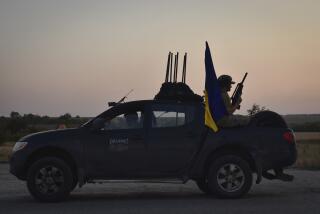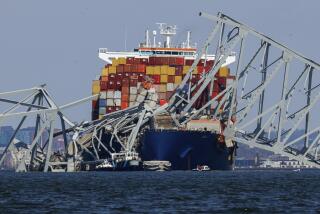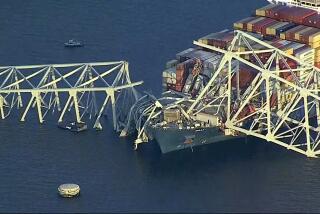Another Bridge to Misunderstanding?
- Share via
KOSOVSKA MITROVICA, Yugoslavia — With this town’s three bridges barricaded by NATO armor and troops, peacekeepers have a new plan to end the division between Serbs and ethnic Albanians. They’re building another bridge.
About 200 yards west of the main bridge between Kosovska Mitrovica’s mainly Serbian north and ethnic Albanian south--a bridge that has come to symbolize the bitter divisions racking Kosovo--French troops began construction on a footbridge across the Ibar River on Wednesday morning.
The NATO-led mission hasn’t explained publicly why a fourth bridge across the river would be any easier to keep open than the existing ones, where the peacekeepers’ vehicles and barbed wire prevent regular traffic from crossing in either direction.
But the biggest advantage of the new link appears to be that it would allow ethnic Albanians to bypass La Dolce Vita cafe, a riverside hangout for Serbian hard-liners.
The footbridge is supposed to allow ethnic Albanians to freely walk to and from three apartment buildings in the north, but Serbian leaders immediately condemned it as a provocation that could spark more bloodshed in a city that has seen escalating tensions and violence.
“I think that bridge will be a new opportunity for Albanians to make trouble,” said local Serbian leader Oliver Ivanovic. “If they want to cross a bridge, they already have the main one.”
The pedestrian bridge should be finished within three weeks and is part of “ongoing negotiations” to unite Kosovska Mitrovica, French Capt. Olivier Saint-Leger said in an interview Wednesday. But Ivanovic said Serbs were neither informed nor consulted before construction began.
Hashim Thaci, the Kosovo Albanian leader with Washington’s strongest support, said in an interview that he hadn’t agreed to the bridge-building plan either. But Thaci added that he didn’t oppose it, despite the risk of creating an ethnic Albanian ghetto within the northern part of the city.
At least nine people have been killed, and 20 injured, in fighting among ethnic Albanians, Serbs and North Atlantic Treaty Organization troops this month. The current round of violence began Feb. 2 with a rocket attack on a U.N. refugee agency bus that killed two elderly Serbs.
NATO commanders met Wednesday with officials from the U.N. administration governing Kosovo--a southern province of Serbia, the dominant republic in Yugoslavia--and the U.N. refugee agency to approve a plan for reuniting Kosovska Mitrovica that would create a multiethnic mingling area in the city’s center. The plan envisions a protected area where people of any ethnic group would feel safe.
Under the same plan, 20 ethnic Albanians and 10 Serbs will be appointed to work in the municipal administration, said Kirsten Haupt, the United Nations’ spokeswoman in Kosovska Mitrovica.
A commission will also be set up to determine which ethnic Albanians have documents to prove they once lived in northern Kosovska Mitrovica so that they can return, said Haupt, adding that refugees may start returning to their homes as early as Monday.
Before Haupt revealed details of the plan, Ivanovic warned of more violence to come in Kosovo’s most volatile town and predicted that “within 10 to 15 days we shall have the climax to everything.”
He accused ethnic Albanians of pursuing a military solution with the backing of the peacekeeping force, called KFOR.
“They are not leading toward calming the situation,” Ivanovic said. “It looks like they are not interested in finding a solution for these issues. They are only waiting for the right moment for bloodshed.
“The final task for Albanians is to expel all Serbs from this area, and that is what everything is leading to.”
In Washington on Wednesday, visiting French officials said that France is sending 600 to 700 more troops to help suppress any violence in Kosovska Mitrovica such as that of recent weeks. The United States also may be asked to put a portion of a 1,800-member Marine unit on special standby to be deployed to the province if warranted by unrest, according to a senior Defense Department official.
Gen. Wesley K. Clark, NATO’s military commander, has asked the alliance’s governing body to put two additional battalions on shortened alert so that they could be moved in quickly, the official said. The Marines belong to a Marine Expeditionary Unit now in Haifa, Israel.
U.S. soldiers returned to the mainly Serbian district of Kosovska Mitrovica on Wednesday to resume weapons searches, three days after stone-throwing Serbs injured two of the paratroopers and forced the Americans to retreat.
The 300 Americans’ early-morning foray into the northern part of the city lasted less than two hours, long enough to arrest eight people for possession of a rocket-propelled grenade launcher, rifles, grenades and ammunition.
No clashes were reported, but peacekeepers face another test Friday, when, Ivanovic said, as many as 4,000 Serbs plan to demonstrate at their end of Kosovska Mitrovica’s main bridge.
Trouble could also flare up if ethnic Albanians hold large rallies Monday to mark the second anniversary of the start of Kosovo’s civil war, Ivanovic said.
On Feb. 28, 1998, Serbian forces attacked the village of Likosane, in the central Drenica region, killing at least 50 people, including 25 women and children. Kosovo quickly descended into all-out war, which formally ended after 11 weeks of NATO airstrikes last spring.
*
Times staff writer Paul Richter in Washington contributed to this report.
More to Read
Sign up for Essential California
The most important California stories and recommendations in your inbox every morning.
You may occasionally receive promotional content from the Los Angeles Times.













